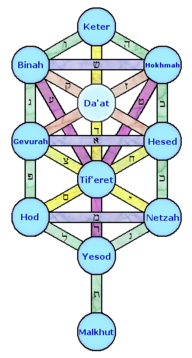Kabbalah
Kabbalah (Hebrew: קַבָּלָה, also spelled Qabbalah, Kabalah, Kabala, or Cabala) literally means "receiving". It is a body of esoteric teachings meant to explain the relationship between an unchanging, eternal and mysterious Ain Soph and the mortal and finite universe.
General description
H. P. Blavatsky defined it as follows:
Qabbalah (Heb.). The ancient Chaldean Secret Doctrine, abbreviated into Kabala. An occult system handed down by oral transmission; but which, though accepting tradition, is not in itself composed of merely traditional teachings, as it was once a fundamental science, now disfigured by the additions of centuries, and by interpolation by the Western Occultists, especially by Christian Mystics. It treats of hitherto esoteric interpretations of the Jewish Scriptures, and teaches several methods of interpreting Biblical allegories. Originally the doctrines were transmitted “from mouth to ear” only, says Dr. W. Wynn Westcott, “in an oral manner from teacher to pupil who received them; hence the name Kabbalah, Qabalah, or Cabbala from the Hebrew root QBL, to receive. Besides this Theoretic Kabbalah, there was created a Practical branch, which is concerned with the Hebrew letters, as types a like of Sounds, Numbers, and Ideas.” (See “Gematria”, “Notaricon”, “ Temura”.) For the original book of the Qabbalah—the Zohar—see further on. But the Zohar we have now is not the Zohar left by Simeon Ben Jochai to his son and secretary as an heirloom. The author of the present approximation was one Moses de Leon, a Jew of the XIIIth century.[1]
Some important concepts
Adam Kadmon
Adam Ḳadmon in the Kabbalistic writings means the "Primal Man". The oldest rabbinical source for the term "Adam ha-Ḳadmoni" is Num. R. x, where Adam is styled, not as usually, "Ha-Rishon" (the first), but "Ha-Ḳadmoni" (the original). In Lurianic Kabbalah, Adam Ḳadmon acquired an exalted status equivalent to Purusha in the Upanishads, denoting an anthropomorphic concept of the universe itself.
Sephirot
Sephirot (Hebrew: סְפִירוֹת Səphîrôṯ), meaning emanations, are the 10 attributes/emanations in Kabbalah, through which Ein Sof (The Infinite) reveals himself and continuously creates both the physical realm and the chain of higher metaphysical realms (Seder hishtalshelus). The term is alternatively transliterated into English as Sefirot/Sefiroth, singular Sephirah/Sefirah etc.
Shekinah
Shekinah is the English transliteration of a Hebrew noun meaning "dwelling" or "settling" and denotes the dwelling or settling of the divine presence of God and his cosmic glory. In Kabbalah it is a feminine divine presence.
Macroprosopus
Macroprosopus is a term used in the Kabbala Denudata for Arich Anpin or Arikh Anpin (Aramaic: אריך אנפין meaning "Long Face/Extended Countenance" is an aspect of Divine emanation in Kabbalah, identified with the sephirah attribute of Keter, the Divine Will.
Microprosopus
Microprosopus is a term used in the Kabbala Denudata for Ze`ir Anpin (Aramaic: זְעֵיר אַנפִּין meaning "Lesser Countenance/Small Face") for a revealed aspect of God in Kabbalah, comprising the emotional sephirot attributes: Chesed, Gevurah, Tiphereth, Netzach, Hod and Yesod.
Tetragrammaton
Tetragrammaton is a term that comes from the Greek τετραγράμματον, meaning "four letters". It refers to the Hebrew theonym (Hebrew: יהוה) transliterated to the Latin letters YHWH, and in Judaism is considered to be a proper name of the God of Israel used in the Hebrew Bible. The most widely accepted pronunciation of the Tetragrammaton (YHWH) is Yahweh, though Jehovah is used in many Bibles, but in few modern ones.
Notes
- ↑ Helena Petrovna Blavatsky, The Theosophical Glossary (Krotona, CA: Theosophical Publishing House, 1973), 268.
Additional resources
Articles
- Kabbalah in Theosophy World
- Adam in Theosophy World
- Adam Kadmon in Theosophy World
- Adam-adami in Theosophy World
- Ain Soph in Theosophy World
- Archetypal World in Theosophy World
- The Kabalah and the Kabalists by H. P. Blavatsky
- Kabalistic Views of "Spirits" by H. P. Blavatsky
- Homuncli, Golems, and Artificial Life by Gary Lachman
- The Kabalah and the Kabalists at WisdomWorld.org
- Hall, Manly P. "Sacred Magic of the Qabbalah, The." Collected Writings of Manly P. Hall Volume 3: Essays and Poems (Los Angeles: Philosophical Research Society, Inc., 1962), 45-91.
Video
- What is Kabbalah? by Boaz Huss. Posted on CIME YouTube channel on December 23, 2021.
Audio
- Gnostic Kabbalah by Stephan Hoeller
- Holy Kabbalah: Ancient Wisdom of Israel by Stephan Hoeller
